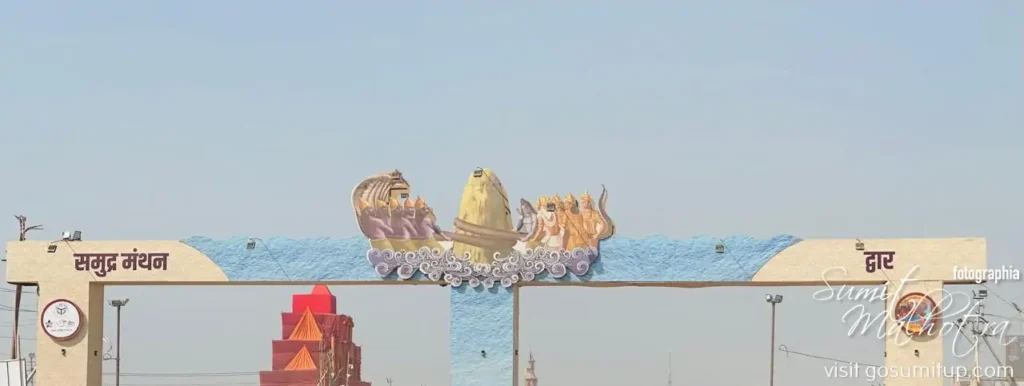The morning air still carried a chill as we left Kanpur behind, the sky just beginning to shift from indigo to a soft orange glow.
The road to Prayagraj was alive — not just with traffic but with purpose.

Traffic jam – mahakumbh
Pilgrims from every corner of India, wrapped in woolens, shawls, or saffron robes, moved like a river parallel to the one we were all heading toward. So there were traffic jams as well.
It was a long drive, but the roads seemed to pull us forward — as if the Mahakumbh Parv itself had sent out a silent call.
We rested for the night, the city lights of Kanpur blinking like weary eyes. Sleep came quickly, dreams tangled with visions of saffron robes, sacred rivers, and chants that rose from some deep, ancient place.
Before the first blush of dawn, we were on the move again. The road from Kanpur to Jhusi in Pryagraj seemed to know we were pilgrims.
As we approached Jhusi, the transformation was striking. What was once a sleepy riverside town had bloomed into a sprawling tent-city — orderly chaos in motion.

Jhusi – a sprawling tent-city — orderly chaos in motion
The UP admin was working at their best, trying to keep everything smooth. Many temporary Fire brigade stations were set up, and so were ambulance points & temporary hospitals, some including ICU.
Ground level police staff were also helpful whenever we spoke to them. Many of them looked very tired, yet enthusiastic.
Traffic was well managed. We got to the Chini Mill parking without any trouble. Everything available was clearly marked on directions hung on the poles. They were easy to read as well.
There were small check points that were letting travellers know convenient roads for entry and exit to the Ghat area. We did hear about:
Roads to & fro tent city were blocked randomly, without any alternative. People had to walk many kilometres with their luggage to get in & get out of tent city. Many people missed their flights & trains. People sat in cars for hours.
Banners flapped in the breeze, blaring the names of akhadas, spiritual camps, and social groups. Loudspeakers echoed with bhajans, safety announcements, and the occasional lost child report.
As the sun began to stretch its arms across the sky and traffic swelled, we safely reached the Chini Mill parking — a sea of parked vehicles and expectant souls. Chini Mill parking was closest to the Ghat.
Our car found its place in the Chini Mill parking, which was impressively well-organized, considering the magnitude of the event.

Chini mill parking jhusi
Uniformed volunteers with lathis and high-visibility vests guided vehicles with practiced ease, while long lines of parked cars stretched across the dusty ground.
Close to the parking, a battery-powered rickshaw was hailed by Hema Suri. This was like finding a chariot from the future, buzzing quietly through narrow lanes and dusty turns.
Amid the crowd, these battery-operated rickshaws zipped along dedicated lanes, ferrying the elderly, tired, or those with children. They were a blessing — quiet, non-polluting, and strangely graceful in their purpose.
The crowds thickened, and the air felt charged — like the atmosphere just before a storm, only this was a spiritual storm, a gathering of millions pulled by faith and time.
All around, the air throbbed with anticipation, and a steady hum of “Har Har Mahadev!” chants kept the spirit high.
As we reached the Ghat, the scene was electric. Wide steps & steel roads led down to the holy river, where thousands had already gathered — some waist-deep, others just arriving, and some frozen in silent prayer.
Temporary tents lined the riverbank, offering changing rooms, lockers, free drinking water, and first-aid stalls.

From the ghat into the boat at triveni sangam
Policemen stood on raised platforms keeping an eye on the crowd, while loudspeakers called out instructions and spiritual encouragement in equal measure.
Despite the sea of people, everything moved — patient, pulsing, synchronized. Volunteers handed out blankets, others swept continuously, and in between the controlled chaos, chai stalls and pakora vendors served comfort to the hungry and cold.
We hadn’t eaten much — just happened to happily find bread pakoras, crisp and humble, and steaming chai, the kind that warms both hands and heart.
The river was calm, but sacred energy danced on its surface. Somewhere downstream, a conch blew.
A group of Naga Sadhus entered with slow, deliberate steps. Others chanted, offered flowers, and took selfies. But for most — including us — this was a personal moment. A soul’s reset.
But the real struggle was finding a boat.
Everyone wanted the same thing — a passage to the Triveni Sangam, the mystical meeting of the Ganga, Yamuna, and Saraswati.
After a long negotiation that felt like bartering with destiny, we finally found a space on a wooden boat that rocked gently in the river’s breath.
Oars sliced through the shimmering water. The chants grew louder. Devotees murmured mantras. Some sat in silence, eyes closed, already halfway to the divine.

Sujit sinha at triveni sangam ghat
Everyone needed to wear life jackets when in the boat. There were many rescue teams in case of an emergency. The oarmen were tired but ready to go as soon as the last devotee sat down
And then — we reached it, our sacred spot at Triveni Sangam for the holy dip.

